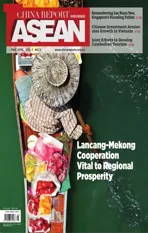Business Prospects in Myanmar
2016-09-26ByXieXiangjin
By Xie Xiangjin
Business Prospects in Myanmar
By Xie Xiangjin
According to an International Monetary Fund (IMF) survey published in April,Myanmar’s economic growth in 2015-2016 is expected to reach 8.6 percent,making the country one of the few frontier economies with fairly strong growth momentum in the Asia-Pacific region.
The survey, titled Regional Economic Outlook: Asia and Pacific, indicated that projected growth in the fiscal year of 2016-2017 is expected to reach 8.4 percent,with an inflation rate of 9.5 percent. This represents higher figures that the country’s growth rate in the 2015-2016 fiscal year,in which growth reached 7.2 percent and inflation was 11 percent.
A bulletin published by the Asian Development Bank (ADB) indicated that since Myanmar’s new government took office, inflation has persisted, but the ADB remains optimistic about the country’s economic prospects. the ADB’s predictions for Myanmar growth are slightly lower than those of the IMF.
Both surveys indicated that Myanmar’s economic slowdown in 2015 had much to do with the slowing Chinese economy in which growth dropped from 7.4 percent in 2014 to 6.9 percent in 2015. Since Myanmar remains extremely close to China in terms of commerce, trade and investment,China’s slowdown has had a significant impact on Myanmar’s economy. Largescale flooding in 2015 also played a role,estimated to have cost the country around 3.5 percent of GDP, or US$1.5 billion.
Despite the fact that Myanmar’s total business registrations dropped from 6,000 in 2014 to 5,000 in 2015, business confidence in the country remained fairly robust,according to Peter Brimble, the ADB’s country specialist in Myanmar. Many foreign firms are taking a wait-and-see approach ather Myanmar’s general election in 2015, but the business climate is generally favorable, Brimble said. According to Oxford Business Group, in the fiscal year of 2014-2015, the GDP of Myanmar’s construction business increased by 7.7 percent. It is expected to increase by 8.3 percent in the 2015-2016 fiscal year.
Myanmar’s newly established economic zones have attracted foreign investment. Infrastructure development in areas of transportation, communication and energy have expanded. There are 40 entities specializing in export trade in the thilawa Special Economic Zone (SEZ), the first of its kind in Myanmar, which is now under construction. The ADB estimates that a total of US$60 billion will be invested in Myanmar’s infrastructure by 2030.
Myanmar used to be the world’s largest rice exporter, and there remains huge potential for agricultural development within the country. The manufacturing sector, meanwhile, is thriving. Labor force advantages may prove a magnet for foreign investors.
Nihon Keizai Shimbun reported that recent statistics of Myanmar’s Directorate of Investment and Company Administration indicated that overseas direct investment in Myanmar from April 2015 to March 2016 increased by 18 percent year-on-year, to a total of US$9.48 billion, the second highest total in the country’s history. Investment in petroleum, gas and related sectors has become the main driver of this growth. As Myanmar’s economic prospects have brightened, overseas investment has begun to pour in.
In terms of sources of overseas investment, Singapore ranks first, making up 45 percent of the total. In numerous cases, enterprises have chosen to invest in Myanmar through financial subsidiaries in Singapore.
China ranks second, accounting for 35 percent of the investment total. Its direct investment to Myanmar increased to six times that of the previous year.
Japan’s investment increased by 260 percent. Its ranking was upgraded to the eighth, compared to the 11th in the previous year.
Following growth in Myanmar’s consumption capacity, numerous foreign brands, including the restaurant Pizza Hut and the fashion house Giordano have begun operations in the country.
The ADB is cooperating with Myanmar in ethorts to expand its transportation infrastructure. Most of the projects will connect Myanmar with Thailand, such as projects starting from Myawaddy of Myanmar and heading to Mae Sot and Bangkok of Thailand, before returning to Myanmar and heading to Yangon. The ADB is also providing loans for civil infrastructure development, including the upgrading of power supply equipment.
The ADB has indicated that Myanmar’s economy is faced with daunting challenges,including the regional environment, fiscal difficulties, ethnic and religious conflicts and an extreme climate. However, the ADB believes that Myanmar has made some significant achievements since economic reforms began in 2011. To go further, the country must face and overcome challenges in infrastructure development, the labor force, political stability and overall social harmony.

About the author:
Xie Xiangjin studied history at the University of Malaya in Kuala Lumpur and is now a research fellow at Aubound. His main research interests include economics,politics and culture in Southeast Asian countries.
